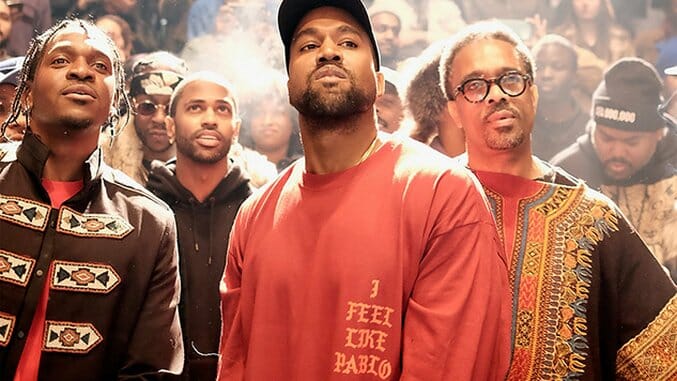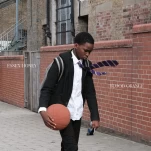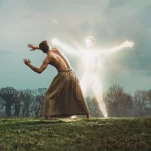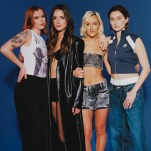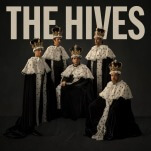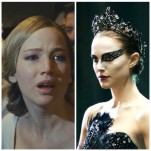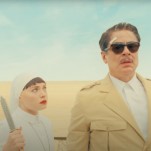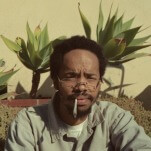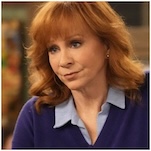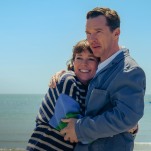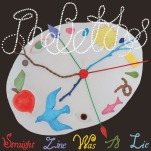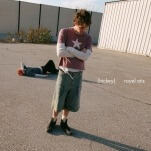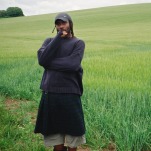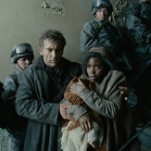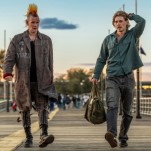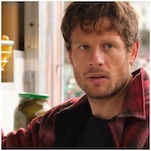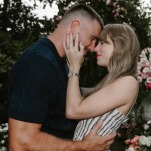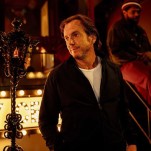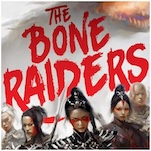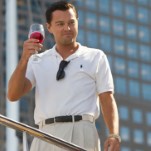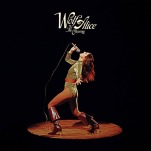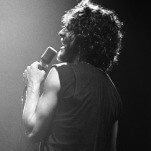We all know this one type of person. Maybe you had an English, film or art class with them. Maybe they’re a friend you talk to about music or movies. Maybe they lent you a book one time and you discussed it with them after.
This person doesn’t just see the big picture; they often go beyond that, seeing everything as possible hints to the biggest picture imaginable. They pull clues from seemingly innocuous word choices, color palettes and blocking arrangements and use them as bricks to build great walls of theory.
Sometimes, maybe even most times, they sound like they’re stretching it. But, once in a while, they hit on a whole theory, or even part of a theory that makes sense. Sometimes they break a work of art down to pieces and then rearrange it in a way that make you think “shit, maybe there’s something to this, something real that I’d been missing all this time.”
Remember this person and that feeling of “shit, maybe…” while we talk about Kanye West’s Yeezy Season 3 show / The Life of Pablo release party / Vanessa Beecroft’s latest installation.
Last week, a hip-hop artist plugged his laptop into the sound system at Madison Square Garden and played his new album to a sold-out crowd.
Last week, a high-fashion designer live-streamed the introduction of a new line to roughly 20 million people around the world.
Last week, an Italian contemporary artist staged a show in New York that 20,000 people payed well over $100 each to attend.
On their own, these happenings are remarkable only in that they took place on a larger scale than one would expect.
What catapults these events beyond remarkable, into the realm of absolutely unheard of, is that they all occurred at once—in the same space, at the same time, primarily as the work of two individuals co-conspiring on a single event. This event was the public unveiling of Kanye West’s new fashion line with Adidas, Yeezy Season 3, as well as the listening party for Kanye’s first solo album in almost three years, The Life of Pablo.
As the event unfolded, Kanye himself repeatedly said, “This shit is not regular.” He was right. It was not.
Of all the irregular parts of this afternoon, from Kanye whittling the MSG sound system down to a single aux cable that he and his entourage passed around, to the entire floor of an arena hosting a fashion show in which nobody moved at all for nearly an hour, one particular dichotomy stood out more and more as time wore on.
Kanye, his entourage, his family, everyone in the audience, everyone watching the stream in theaters or at home—all of these people were smiling as the long-awaited album played, clapping between songs, laughing at punchlines. But, on the floor of MSG, hundreds and hundreds of models and extras stood stone still, not one of them smiling, clapping or laughing. At times, they looked like they were suffering.
It would turn out that the models’ apparent displeasure was by design, as an exhaustive list of instructions handed out to the models leaked, and an extra later gave her account of the whole experience confirming explicit instructions to channel a Rwandan refugee. It would also turn out that the obscure, chaotic photo on the Yeezy Season 3 flyer was not just a vague reference for the line’s theme of distressed earth tones. Rather, it was a photo taken from the site of the Kibeho Massacre, which took place during the Rwandan genocide. It was a photo of a site of a mass murder, shot just one day after thousands of people were gunned down, and Kanye and artist Vanessa Beecroft had recreated it, intentionally, to a recognizable degree, as the setting for their fashion show / the staging of their temporary art installation / the centerpiece for The Life of Pablo listening party.
Why? Why recreate this image in these circumstances? Why stage these two seemingly contradictory events, with two wholly contradictory tones, in unison?
Some people may say that this was an oversight due to Kanye being the ass he so often appears to be when the media spotlight is directed onto him. Others may say that it was another example of a crude lack of racial understanding by Beecroft, whose past attempt to adopt “orphaned” Sudanese twins (they lived in an orphanage, but actually had a father), was documented in the film The Art Star and the Sudanese Twins.
Those are possibilities. But, like it or not, Kanye West is not just the ass he looks like on the news, and Beecroft is not just the selfish lunatic she sometimes appears to be in The Art Star and the Sudanese Twins. These are two intelligent, though admittedly flawed, artists. They have intentionally employed contradiction in the past to prompt questions, make points, and spur complex thoughts. They have kept the type of person who looks for the big picture in everything awake at night. They have inspired more than their fair share of moments where one heard a complex theory about their work and thought, “shit…maybe.”
There’s good reason to believe that there’s something to the contradiction on the face of the Yeezy Season 3 staging — a point, an argument, a seed of a thought. What might that be?
III
When it comes to modern musical acts who indulge in contradiction in a broad sense, Kanye West may be the king.
From the start of his career, his very character has been a sort of contradiction. He broke into the mainstream rap scene without conforming to any of its tropes. His initial public persona of the smart, well-to-do backpack rapper did not fit into the neat boxes of the aggressive, luxurious, or even wholly conscious acts that had done well before him.
Look at the lyrics for songs like “All Falls Down” or “Family Business” off his first album, The College Dropout, and you’ll see contradictions inside of one another like nesting dolls. Beneath the rapper (in practice), who isn’t a rapper (in persona) was a guy who loved luxury goods, but also saw the damage they could do, a guy cool enough to have his hip-hop album go double-platinum, but also humble enough to talk about peeing the bed as a kid.
Kanye’s contradictions continued over the years, in his lyrics, his actions, and in his critical reception. His use of contradiction is still alive today, and displayed as prominently as ever on his latest album, The Life of Pablo, where he paints pictures of religious devotion one second, and crass, sex-obsessed selfishness the next.
These contradictions are not oversights. When they appear in his lyrics, Kanye often addresses them in the same song, confirming that he can identify and understand them. When contradictions appear in his behavior, he often addresses them publicly, like in his speech at the 2015 VMAs where he talked about his infamous Taylor Swift incident, stating, “The problem was the contradiction. The contradiction is I do fight for artists, but in that fight I somehow was disrespectful to artists.”
If we can accept that Kanye purposely plays with contradiction in his persona, his lyrics, and his actions, the question becomes why. During a 2013 interview, critic Charlamagne Tha God pressed Kanye on being “a walking contradiction” for what Charlamagne perceived to be Kanye’s simultaneous hate of corporations and desire to be accepted by them. Kanye denied that specific instance of contradiction, arguing that he doesn’t hate corporations, but is often frustrated by those that refuse to work with him in his fashion pursuits. However, he did end the interview with a statement that could partially explain his use of contradiction. In closing he said, “Hate and love are very similar emotions. The opposite of love is, you don’t care.” This sentiment that any attention is better than no attention is laced throughout his lyrics, from the 2005 song “Bring Me Down,” in which he says, “Everybody feel a way about K, but at least y’all feel something,” to 2016’s “Father Stretch My Hands Pt. 1” where he says, “Everybody gon’ say something, I’ll be worried if they say nothing.”
Could the Kibeho-inspired staging of Yeezy Season 3, and the apparent contradiction between that tragedy and the jubilation of a long-awaited record release party, simply be a move to inspire talk, thought and attention? If Kanye were the only person involved in the staging, this idea would be fairly reasonable. However, Kanye did not work on Yeezy Season 3 alone.
Kanye’s creative partner for each of his Yeezy Season shows, Vanessa Beecroft, can be quite the contradiction herself. And like Mr. West, she is often aware of, and critical of, her own contradictory thoughts, words and deeds.
A 2005 article on Beecroft in The Guardian chronicles the contradictions in her personality, and their relationship to her work: she considers her performances self-portraits but rarely appears in them herself; she is supported by powerful fashion figures yet claims not to follow fashion; she’s plagued by eating disorders but doesn’t care to label herself bulimic or anorexic; she’s obsessed with control yet surrounded by powerful people; she’s very much an artist of the moment but isn’t interested in any contemporary art after the abstract expressionists; she’s happy to put naked women on public display but finds being photographed herself agonizing.
Beecroft shows awareness of her own sometimes contradictory nature in a 2008 Washington
Post article that mainly covers The Art Star and the Sudanese Twins. The art product that came from her Sudan trip is a photo of her posing as Mary, nursing the twins she attempted to adopt. Yet, the film itself contains many instances of Beecroft acting, and being perceived, as anything but the ultimate female religious figure. The Washington Post article calls the film a “story of vanity and obsession.” At one point in the film, Beecroft prompts her photographer to hurry a shot of the twins, and tells her assistant to cover the windows of the room, because she fears that she and her crew look like “white monsters” to the Sudanese people watching outside. When asked about the possibility of people disliking her based on her appearance in the film, she says, “I totally agree. I don’t like myself either.”
In a 2016 interview with the creative blog It’s Nice That, Beecroft talks about a show in Berlin named VB55, describing a scene that is eerily similar to that which took place at the Yeezy Season 3 show. She says, “I saw two sides: the women naked on one side and the audience. Super dressed up. High society. And in that relationship you have the dichotomy that defines the world in which we live: the wealthy world and the other. The rich, looking on, interested, but still happy to be removed from the other world that is naked, and in some cases falling apart.” This is nearly the same type of creation as Season 3, one space where two seemingly contradictory worlds clash and stare at one another. Offering an overall summary of her work to The Washington Post, Beecroft had said that the point of certain details is often “to create a little bit of irritation for the audience.” Contradiction can, and often will, do that.
IV
To West, contradiction is partly a tool to keep people talking, thinking and even obsessing about his music. To Beecroft, contradiction is partly a tool to provoke irritation within privileged society, getting people to think about the “other world” that is in need of attention.
Given all of this, the contradictory tones at play during the Yeezy Season 3 show start to make some kind of sense. It was the work of two artists who embrace contradiction for different, yet similar, purposes.
Even with all of this theory presented, a vital question still remains unanswered: Why recreate a photo of Kibeho? Why not any other tragic happening? Any tragedy at all would have provided a contradictory scene to Kanye and his friends, family and fans’ celebration of a long-awaited record release.
There may be no definite answer to this question, but further research into West, Beecroft and Kibeho leads to some interesting possibilities.
For Kanye’s part, the possible connection to Kibeho centers around the Virgin Mary. Kanye, who refers to himself as Yeezus on his previous album, used a thirteenth century masonic symbol for the Virgin Mary as the artwork for his 2015 single “All Day,” and even got the symbol tattooed on his right arm. If Kanye is Yeezus, his late mother Donda is presumably some take on the Virgin Mary. A connection between the Virgin Mary and the Kibeho recreation on the stage would help explain the otherwise head-scratching moment during the Yeezy Season 3 show where Kanye previewed a video game he’d been working on that featured his mother as an angel finding her way to heaven.
What does any of that have to do with Kibeho, Rwanda? Well, it turns out that in the 1980s, Kibeho was the location of a string of Marian apparitions, the only supernatural sightings of the Virgin Mary approved by the Catholic Church in all of Africa. A group of teenage girls reported seeing an apparition of Mary and claimed that she showed them visions that foretold the 1994 Rwandan genocide.
Beecroft doesn’t appear have a direct reason to be interested in Kibeho or the Kibeho Massacre specifically. However, she does have a direct link to the African continent throughout her work, specifically the photo of her with the Sudanese twins she attempted to adopt. Beecroft herself says that her trip to Sudan began as a trip to Darfur based on her interest in the conflict there, though she never did make it to that area or document the conflict at all. She summarized her reaction to her Sudan trip saying, “Sudan is a microcosm of Africa and of the blacks in the world, and I know it is presumptuous of me to take this subject under my wing, but I actually want to. It is my interest now.”
Lastly, West and Beecroft teamed up for Yeezy Season 1 and Yeezy Season 2, both of which had military themes. Season 1 involved a small group of models in a dark space, something like a rag-tag army. Season 2 had a larger cast in a bigger, brighter space. The models’ movements were reactions to military instructions called out loud. From Season 1 to Season 2, the “army” seemed to grow and become more sophisticated. Then, in Season 3, the models were no longer posed as an army, but as a group of refugees. Why? Perhaps, with a current world-wide refugee crisis in the news, the change was made to pose the idea that the military and the victims of the military are in some ways interchangeable—similar in appearance, similar in dress, similar in basic humanity.
Offering unintentional support to the idea that invoking Kibeho was meant to make a humanitarian point, Paul Lowe, the photographer who shot the original photo featured on the Yeezy Season 3 flyers, and the photo that the show’s staging was based on, said in an interview with TIME, “If people want to find things in my work that is relevant and useful to contemporary issues and contemporary politics, that’s great. And the fact that an image that is 20 years old can still resonate today is indicative that there’s still a lot to do.”
V
Whether the contradictory tones at the Yeezy Season 3 / The Life of Pablo release party at Madison Square Garden were intentional or not, whether they were meant to keep Kanye West in the news, or to spur irritation and discomfort, or to suggest a larger point or series of points, one thing cannot be denied—this level of analysis cannot be applied to many fashion shows, and certainly cannot be applied to any hip-hop record release party that I’ve ever heard of.
Remember that type of person we talked about to start all of this? The one who sees not just the big picture, but the biggest picture, even if it means taking some liberties with connections and making some assumptions about intent? Kanye speaks to that type of person in a way that no hip-hop artist ever has, perhaps in a way that no musician in any genre has over the last few decades.
Maybe that’s what great art is all about.
